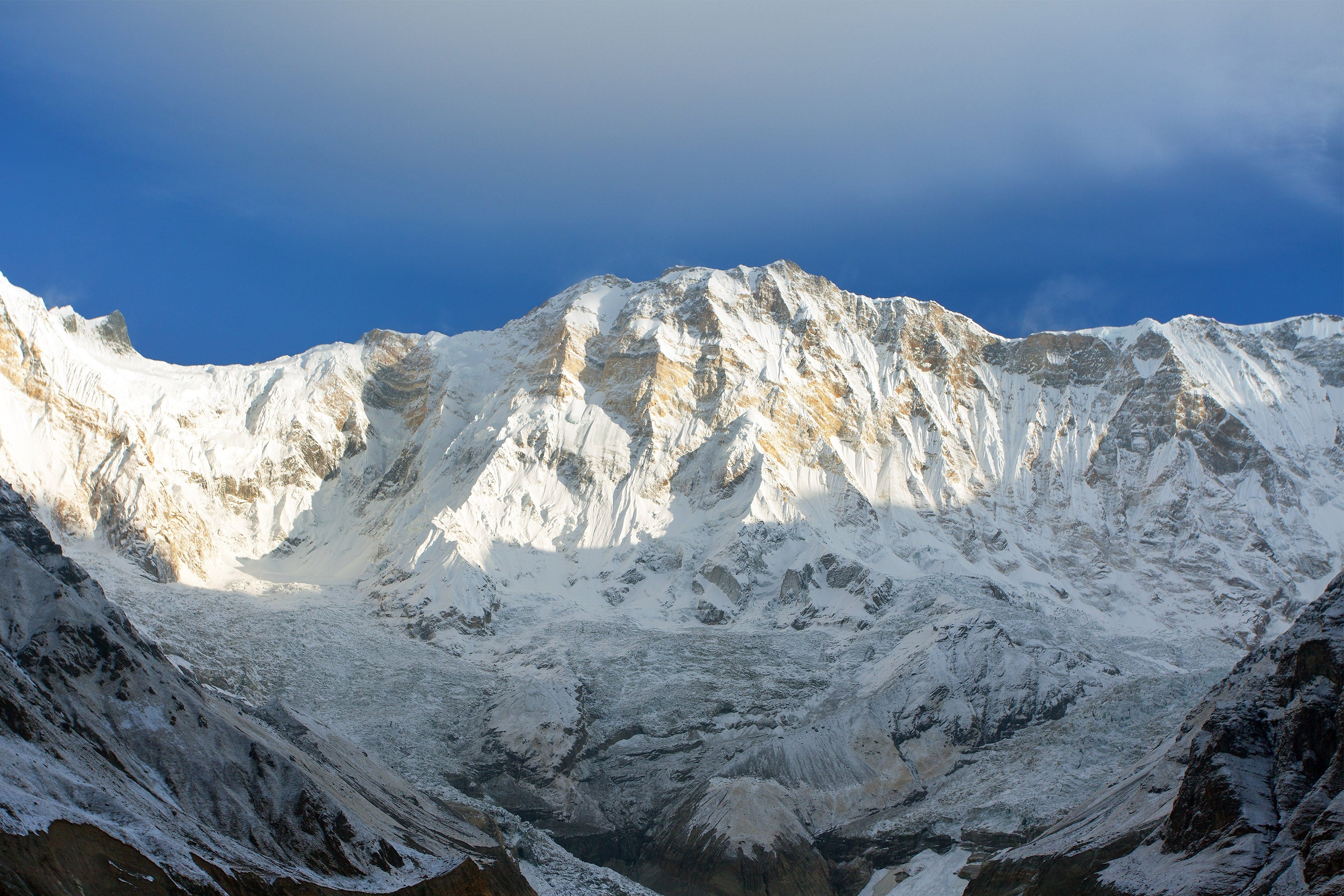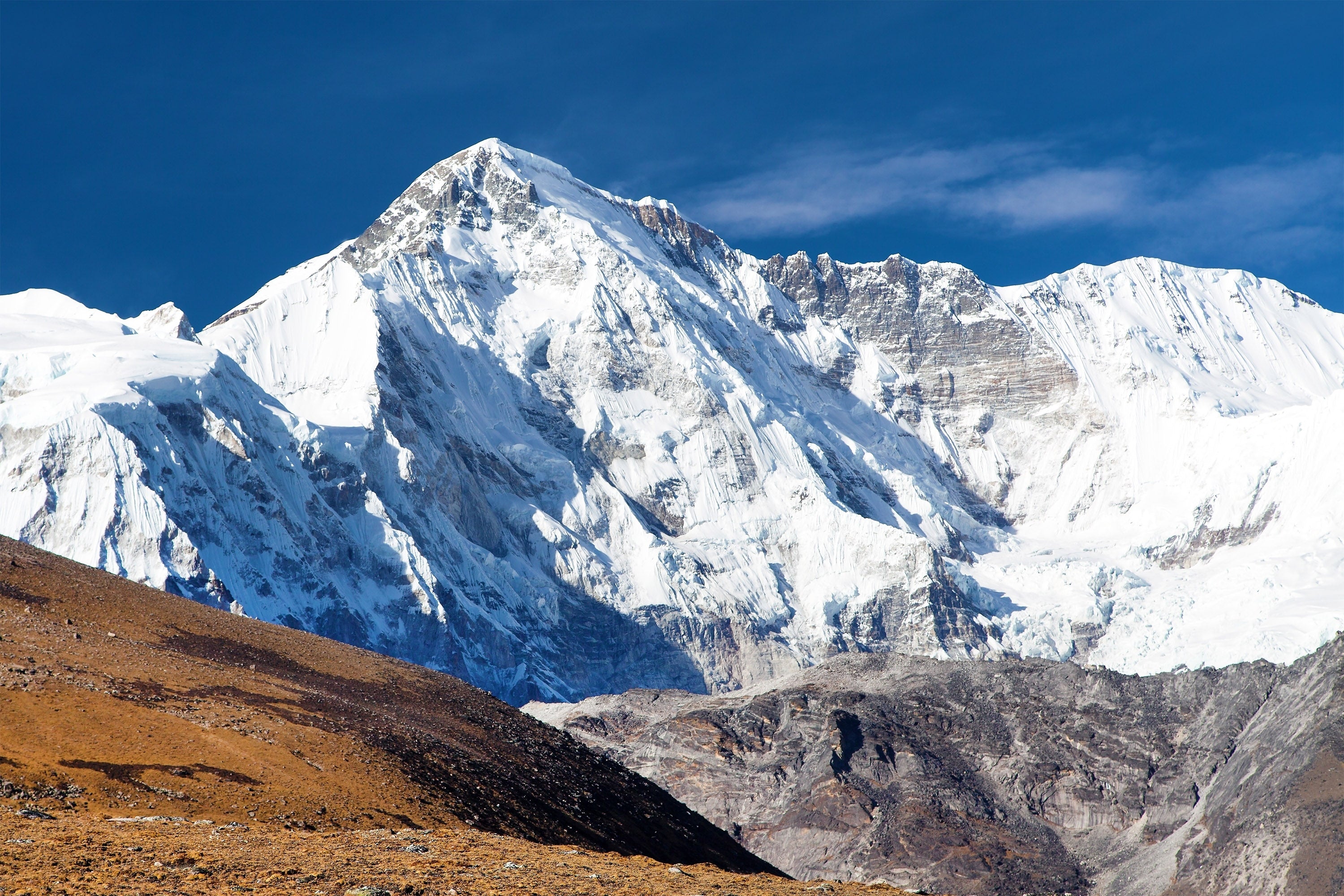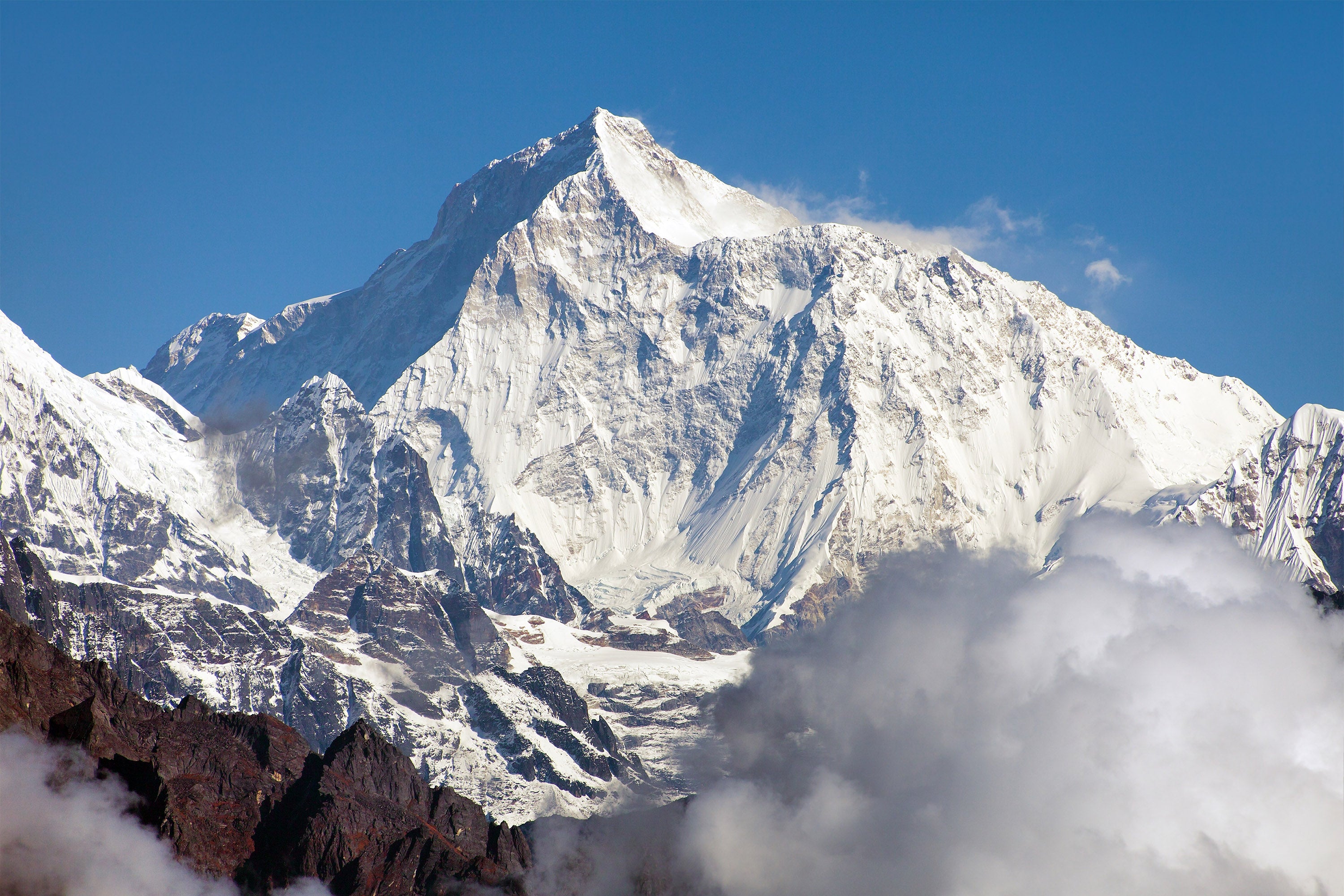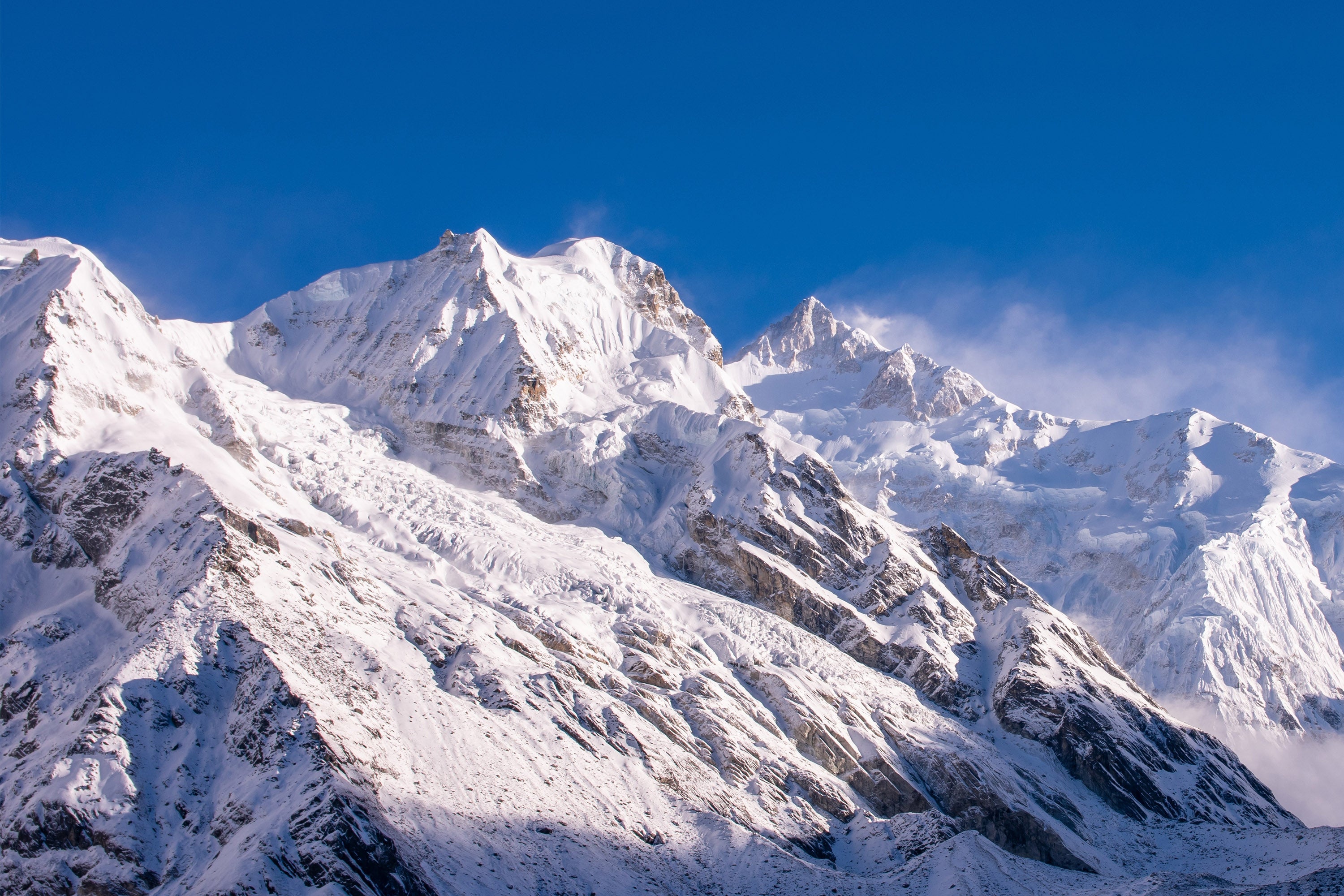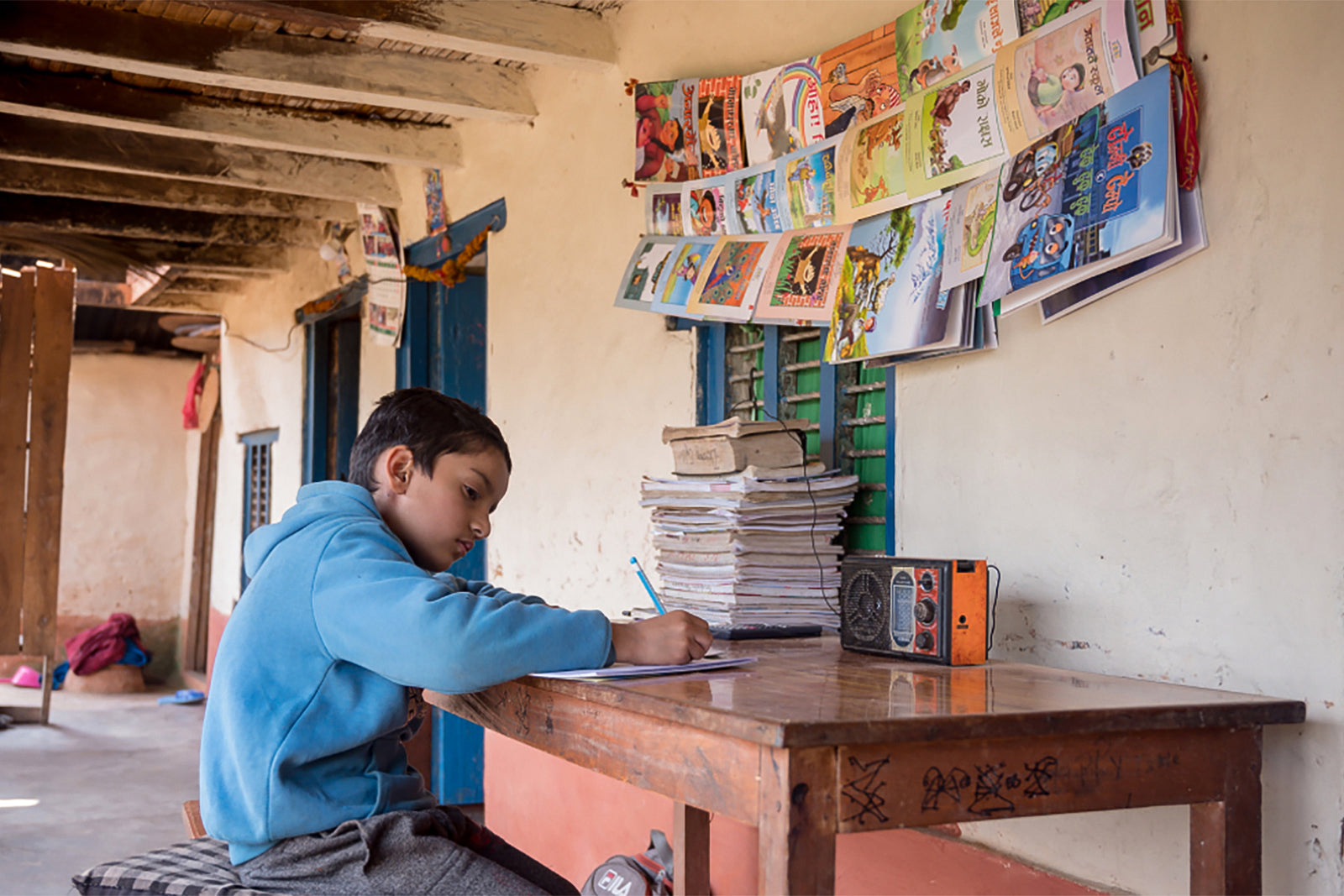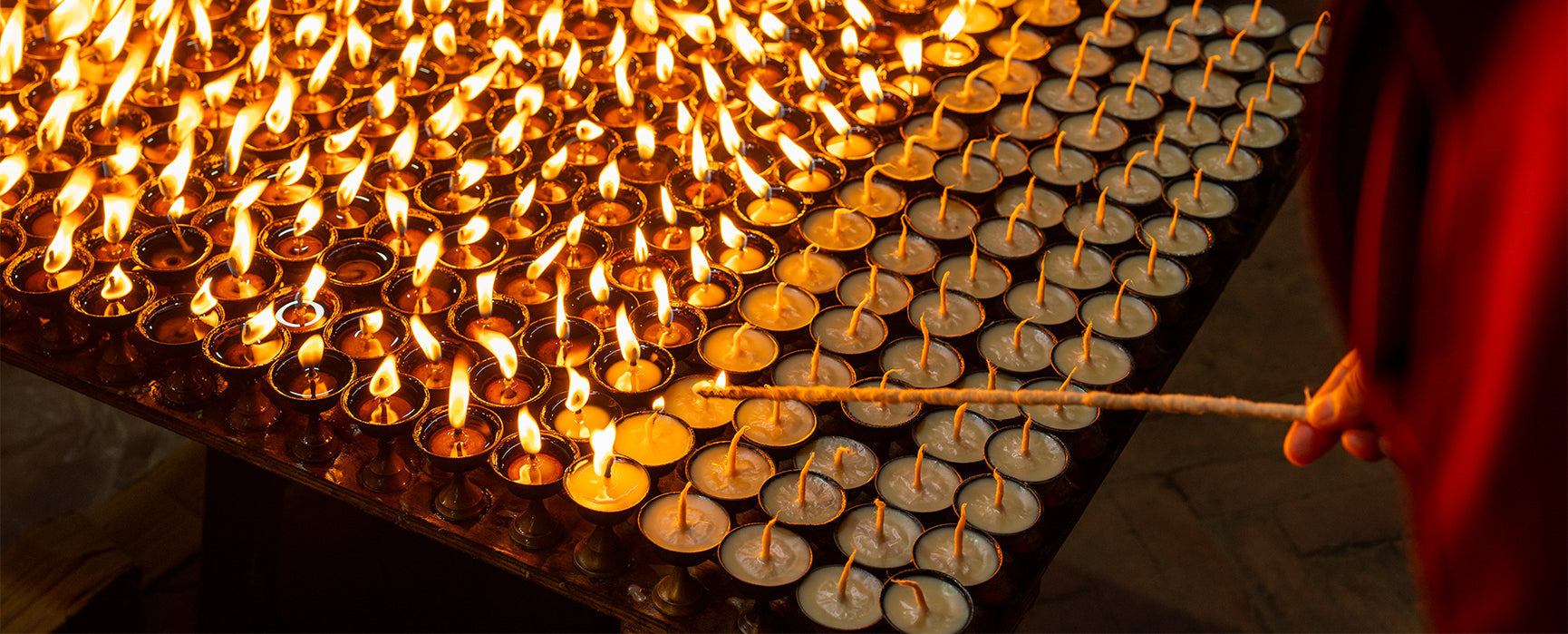
The 14 Highest Mountains of Nepal
Nepal has long been renowned for its awe-inspiring Himalayan Mountain ranges, and with 14 mountain peaks that surpass 8,000m above sea level, it’s no wonder why. Due to developments in mountain study and GIS technologies, more separated peaks have been found within the Himalayan Mountains, which has resulted in Nepal’s department for tourism updating its peak profile database. These newly identified peaks are known for their particularly difficult ascents, due to their locations being in the most isolated areas of the Himalayas.
Previously, it was thought there were just 14 mountain peaks that surpassed 8,000m in the world. That number has now been moved to 20, with 14 inside Nepal. Whilst international confirmation of the new eight-thousanders is yet to be finalised, we have included the new peaks from Nepal’s database in this blog post.
14. Yalung Khang West
Elevation: 8,077m (26,499 ft)
First Recorded Ascent date: May 14, 1973
Yalung Khang West is the fifth highest peak in the Kanchenjunga Himalayan Mountain Range, which is found in the Taplejung district of Koshi Pradesh, Province 1.
The mountain is considered sacred by the Sherpa and Limbu people who live in the region. Rituals and ceremonies are held within these local communities to honour the mountain.
With its sheer faces, icy slopes and complex ridgelines, this mountain is a highly technical climb that requires advanced mountaineering skills. As a result of its remote and highly challenging nature, it is one of the least-climbed mountains.
13. Annapurna I
Elevation: 8,091m (26,545 ft)
First Recorded Ascent date: June 3, 1950
Annapurna I is the highest peak of the sacred Annapurna massif (compact group of mountains), of which there are many peaks over 7,000m. This group of mountains is found in the Myagdi and Kaski districts of Gandaki Pradesh.
Annapurna is considered one of the most sacred places in Nepal and is named after the Hindu Goddess of nourishment, with ‘anna’ and ‘purna’ literally translating to ‘grain’ and ‘abundance’. It is also believed that Lord Shiva lives within this mountain range. The local Gurung people have long considered the mountains as their provider of food, resulting in a deep respect shown through worship and rituals.
In June 1950, Annapurna I became the first-known 8,000-metre mountain in the world to have been successfully summited. This mountain is also one of the world’s most dangerous summits due to unpredictable weather, avalanches, and icefall.
12. Manaslu
Elevation: 8,163m (26,782 ft)
First Recorded Ascent date: May 9, 1956
Manaslu is part of the Mansiri Mountain Range, found in the Manang and Gorkha districts of Gandaki Pradesh.
Manaslu is a spiritually significant mountain, known as the ‘Mountain of the Spirit’ to local people. Manaslu in Sanskrit translates to ‘manasa’, which means ‘intellect’ or ‘spirit’. The region around Manaslu is considered sacred and is well known for its deep ties and traditions in Buddhist culture, seen through the presence of ancient monasteries throughout the region. Due to the spiritual and biodiverse significance of this area it is restricted, and those who want to witness the beauty of the landscapes here have to obtain a permit.
The Manaslu circuit is known for its diverse landscapes, cultural encounters and rare wildlife.
11. Dhaulagiri I
Elevation: 8,167m (26,795 ft)
First Recorded Ascent date: May 13, 1960
Dhaulagiri I is found within the Dhaulagiri Mountain Range in the Myagdi district of Gandaki Pradesh.
The mountain is known for its majestic beauty with ‘Dhawala’ and ‘giri’ meaning ‘white’ and ‘mountain’, and its unique mound shape. It’s a difficult mountain to ascend, with many icy glaciers, steep rock faces and unpredictable weather. This mountain holds great spiritual significance with the local people who regard the peak as a living source of energy.
Dhaulagiri I is known as the highest mountain in the world within the borders of a single country. Throughout the 1950s there were numerous failed summit attempts, but in May 1960, a Nepali-Swiss-Austrian expedition successfully made the first ascent to the mountains peak.
10. Cho Oyu
Elevation: 8,188m (26,864 ft)
First Recorded Ascent date: Oct 19, 1954
Cho Oyu stands on the border between Nepal and Tibet in the Khumbu district of Koshi Pradesh, Eastern Nepal. The vistas seen from the ascent of the mountain include Sagarmatha (Mt Everest), Lho Tse and the Tibetan Plateau.
In the Tibetan language Cho Oyu means ‘Turquoise Goddess’. It is thought the mountain gets this name as the mountains’ shadows appear turquoise at sunset.
Cho Oyu is also known to mountaineers as one of the best for high-altitude climbing. Whilst it’s still an incredible feat to summit an 8,000m mountain, if ascended via the North-West Ridge, it’s a less technical ascent than others of similar altitudes.
9. Lho Tse Shar (also known as Lho Tse II)
Elevation: 8,400 (27,559 ft)
First Recorded Ascent date: May 12, 1970
Lho Tse Shar is the eastern sub-peak of Lho Tse massif and third highest peak within this compact group of mountains. Lho Tse Shar is located in the famous Khumbu Mountain Range of Koshi Pradesh’s Solukhumbu. While this area is well-known for its high-elevation mountains, the isolated location of Lho Tse Shar means it wasn’t ascended until 1970.
Known for its ice walls and steep ridges, Lho Tse Shar is one of the most difficult peaks to ascend. Climbers must have an incredibly high level of technical ice-climbing skills and ability to tackle steep slopes and erratic snow conditions.
While mountains in the Lho Tse massif are not known for specific spiritual significance, the entire Himalayan range is considered sacred in Hinduism and Buddhism, the major religions of Nepal. Peaks are regarded as the homes of deities and the rivers that originate in these mountains are considered sacred.
8. Lho Tse Middle
Elevation: 8,413m (27,601 ft)
First Recorded Ascent date: May 23, 2001
Lho Tse Middle is the most recent peak to be listed as an eight thousander. Due to its isolated location, and the fact there are no ridges that directly lead to the peak, this subsidiary peak also holds the record as the highest unclimbed eight-thousand-metre mountain for the longest period of time. This mountain is also known to be an incredibly difficult and technical climb.
Like Lho Tse Shar, Lho Tse Middle is located in the famous Khumbu Mountain Range of Koshi Pradesh’s Solukhumbu, and to the south of Sagarmatha (Mt. Everest). The expedition of this mountain begins at Everest base camp and follows the South col route up to the Yellow Band; Everest climbers turn left, and Lho Tse Middle climbers take a right further along the Lho Tse face.
7. Makalu I
Elevation: 8,463m (27,766 ft)
First Recorded Ascent date: May 15, 1955
Makalu I is found on the border of Nepal-Tibet in the Mahalangur range of Koshi Pradesh. There are different indigenous communities who live here such as the Rai, Limbu and Sherpa people.
This mountain is approximately 19km South-East of Mt. Everest. Makalu I is a major subsidiary peak of the mountain Makalu, and it is also considered to be more difficult to climb than Sagarmatha (Everest).
One standout feature of Makalu I is its structure, which is a pyramid shape. The terrains found here are renowned for their beauty and variety, from rugged mountainous terrain, rivers, and dense forests to rich cultural heritage and remote villages.
6. Kanchenjunga South
Elevation: 8,473m (27,799 ft)
First Recorded Ascent date: May 19, 1978
Kanchenjunga South stands on the border between Koshi Pradesh, Nepal and the Sikkim state of India. The indigenous people who inhabit the region are primarily the Sherpa, Limbu, Magar and Rai communities.
The Kanchenjunga Mountain region is known for deep spiritual ties and significance. The predominant religion of this region is Tibetan Buddhism; pilgrimages are performed in the area and there are numerous Buddhist monasteries found throughout the range.
Treks to the base camp of this mountain often start and finish in Kathmandu, with September to November being considered the best months for climbing this mountain, while March to May is the most popular time for trekkers. There is a diverse ecosystem along the route of this trek, from temperate forests to Alpine meadows and glaciers.
5. Kanchenjunga Central
Elevation: 8,476m (27,808 ft)
First Recorded Ascent date: May 25, 1955
128km to the east of Sagarmartha (Everest), Kanchenjunga Central is one of the four 8 thousanders found within the Kanchenjunga massif. This peak also shares the border between Koshi Pradesh, Nepal and the Sikkim state of India.
Kanchenjunga Central is considered the 5th highest peak of Nepal, and the 3rd highest within the five major subpeaks of the Kanchenjunga massif. Of these subpeaks, four of them feature on the 8,000m list. The name Kanchenjunga can be translated to ‘The Five Treasures of the Great Snow’, a reference to the 5 subpeaks. This mountain massif holds strong spiritual significance and is believed by local communities to house deities.
4. Yalung Khang
Elevation: 8,505m (27,904 ft)
First Recorded Ascent date: May 14, 1973
Yalung Khang, also known as Kanchenjunga West, is the second-highest peak in the Kanchenjunga Himalayan range. Due to the isolated location of this subpeak, as well as technical climbing obstacles and extreme weather conditions, it hadn’t been summitted until 1973, when Japanese climbers Takao Matsuda and Yutaka Ageta reached the peak.
As with all mountains within the Kanchenjunga massif, this mountain is considered sacred by the Sherpa, Rai and Limbu people who live in the region. Rituals and ceremonies are held within these local communities to honour the mountain.
3. Lho tse
Elevation: 8,516m (27,940 ft)
First Recorded Ascent date: May 18, 1956
Lho Tse, also known as Lhotse, is currently considered 4th highest peak in the world. It is known for razor sharp ridges and dramatic elevations. Lho Tse is sometimes referred to as The Silent Giant. Standing on the border in the Solukhumbu District of eastern Nepal, and the Dingri County of Tibet, this mountain is part of the Mahalangur massif, south of Mount Everest (Sagarmatha).
This mountain is known for its spiritual importance within Tibetan culture. It is believed the Goddess of Divination and Light is housed within the peak of this immense mountain.
Climbing this peak involves huge amounts of skill and is an incredibly technical climb. Due to being one of the most challenging peaks of Nepal, Lho Tse is also one of the least summitted. The Lho Tse Face is well known for a vertical wall of glacial ice that reaches approximately 1125m in height. This ice wall is thought to be one of the most challenging and dangerous of the Himalayan climbs.
2. Kanchenjunga
Elevation: 8,586m (28,169 ft)
First Recorded Ascent Date: May 25, 1955
Kanchenjunga was once considered the highest mountain in the world. Today, it is known as the world's 3rd highest mountain and features the highest point of the Brahmaputra River basin – one of the world's largest river basins. This mountain is the highest peak of the Kanchenjunga massif and is found standing on the border between Koshi Pradesh, Nepal and the Sikkim state of India.
Kanchenjunga is considered a sacred mountain particularly by the Lepcha people in Sikkim, and it is believed to be both a deity and the home of deities. Climbers traditionally stop before the summit out of respect and to honour the sacred significance this mountain holds for local people. In 1955, out of respect, the first-known international expedition up this mountain also observed stopping before the summit.
Climbing this mountain is incredibly difficult due to the technical skill needed to climb, the isolated location and terrain involves steep ascents, crevasses and avalanche-prone areas. The unpredictable weather and physical and mental demands of the mountain also contribute to the difficulty of summitting this mountain.
1. Sagarmatha (Mt. Everest)
Elevation: 8, 849m (29,032 ft)
First Recorded Ascent Date: May 29, 1953
Sagarmatha mountain, also known as Chomolungma in Tibetan, stands on the border between Nepal and Tibet. This majestic mountain is considered the world’s tallest mountain. Found in the Himalayas of Eastern Nepal in the Solukhumbu district, the Sagarmatha National Park, in which the mountain stands, was created in 1976 to preserve the area.
In the surrounding area there are monasteries and stupas, which reflects the deep spiritual significance the people of Nepal and Tibet share with the mountain. In Nepali, Sagarmatha translates to ‘Forehead of the Sky’, which reflects the spiritual connection the mountain holds between the earthly realm and the divine. In Tibetan, Chomolungma translates to ‘Goddess Mother of the World’. For the Sherpa people, the mountain is considered to be the dwelling of deities and Sherpa communities perform ceremonies including pujas (ritual offerings) and chhewar (initiation rites) to honour the mountain.
There are numerous notable people from the Sherpa community who have summited this mountain. Tenzing Norgay Sherpa was the first to summit this mountain in 1953 alongside Edmund Hillary; Kami Rita Sherpa holds a record of 31 successful climbs of Everest, with the most recent being 27th May 2025; Lhakpa Sherpa became the first woman to summit Sagarmatha in 2000, and by May 10th 2012, she made a record of summitting Sagarmatha 10 times.
Each of Nepal’s 14 tallest peaks holds a sacred place in the hearts of those who call these mountains home. Their quiet strength and spiritual presence inspire everything we do. It’s this deep-rooted connection to the Himalayas that we strive to honor in every product we create.
